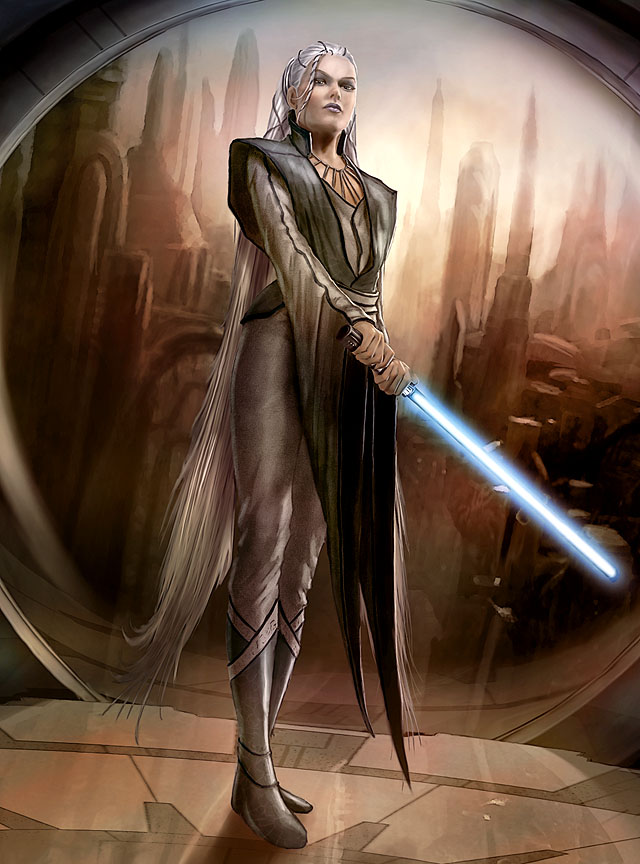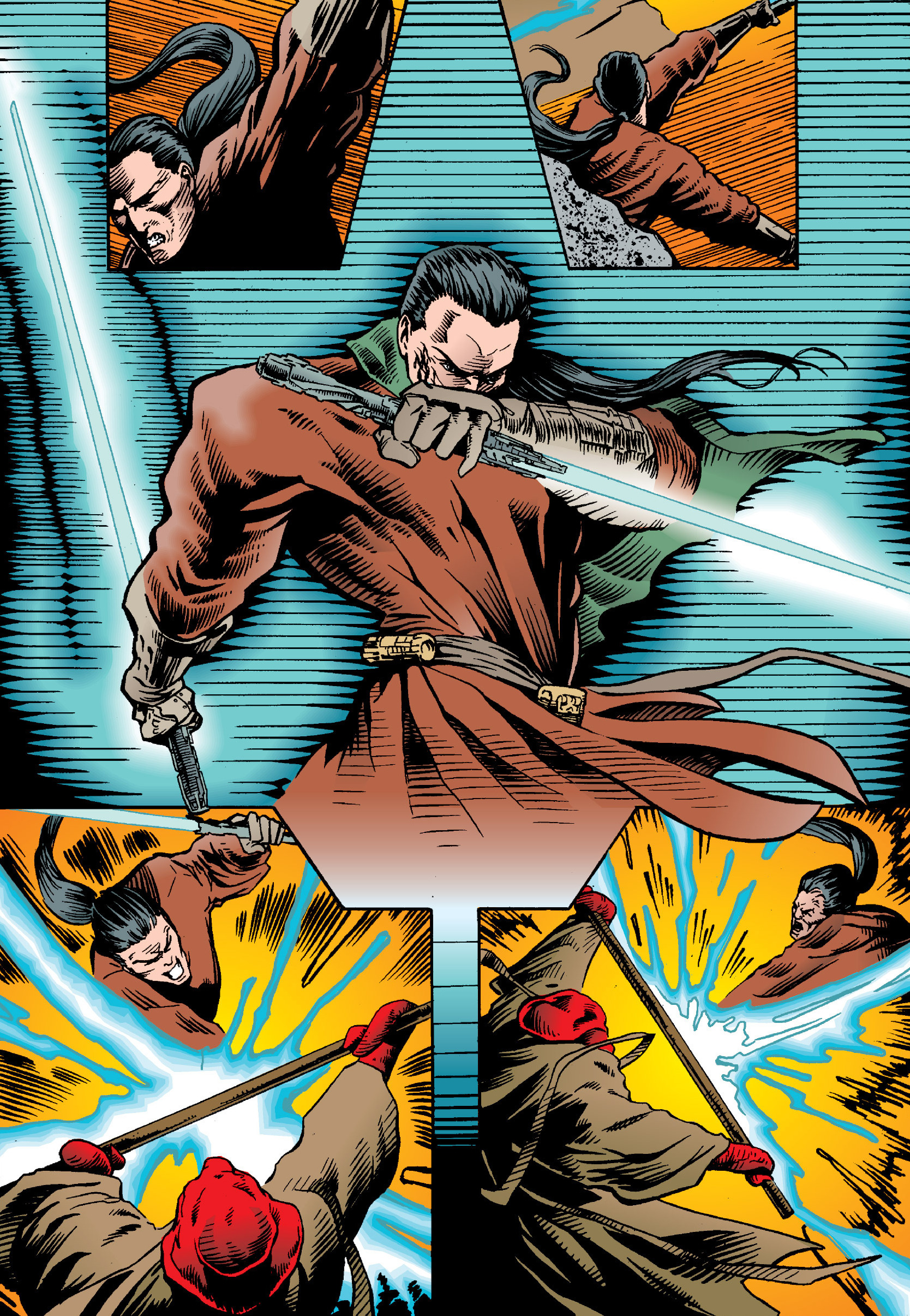Niman Form
"For superior balance, use the Niman form. This form has no specific strengths, but no weaknesses either." ―KavarForm VI, also known as Niman, the Way of the Rancor, the Moderation Form, and the diplomat's form, was the sixth form of the seven forms of lightsaber combat. This fighting style was a hybrid martial art created by effectively combining elements of the preceding lightsaber forms into a single, generalized form. Niman balanced out between the various specializations of the other forms, covering many of the basic moves, but focusing on overall moderation. This resulted in a fighting style that lacked a significant advantage, but also lacking any serious drawbacks, and thereby not leaving adherents as exposed as some of the more aggressive or specialized forms. Overall, Niman had a fairly relaxed focus on bladework, designed as a simple, easily mastered fighting form for Jedi who preferred to devote most of their time to study and diplomacy. Despite this, it could be absolutely deadly in the hands of a skilled practitioner, as demonstrated by such notables as Exar Kun. To compensate for the relaxed focus on bladework and lack of significant specialization, Niman training regimens encouraged the inclusion of Force-based attacks in combat, such as telekinetic pulls and shoves used in sync with lightsaber strikes. Also, as Niman was developed from two pre-existing martial arts fighting forms that both emphasized the use of dual-blades, it provided a firm foundation for duelists looking to study into such practices. Ultimately, Niman's success in combat was dependent on a practitioner's intuition and creativity in combat, rather than the rote responses common to the other forms. During the various wars against the Sith, Niman was prized by some for its general versatility on the battlefield, though heavily criticized by others for being insufficiently demanding. Over time, it became the standard in lightsaber training, and by the start of the Clone Wars, it was one of the most common forms in the Jedi Order. However, Niman demonstrated itself to be inadequate for the open battlefields of the Clone Wars, proven when all the Form VI adherents involved in the First Battle of Geonosis died in combat. In the post-war years, Niman remained studied and practiced amongst the Sith while the Jedi were hunted down in the Great Jedi Purge. Form VI lightsaber combat would eventually be rediscovered by the New Jedi Order, though until then, it was effectively replaced as the favored "jack-of-all-trades" fighting style by the Medium style of lightsaber combat.
Description
"It is often referred to as the diplomat's form because it is less intensive in its demands than other disciplines, allowing Jedi to spend more time developing their skills in perception, political strategy, and negotiation." ―Cin DralligA hybrid fighting style, Niman incorporated elements from the previous forms, mainly Forms I through V, excluding Form II, but balanced out between their various specializations, in keeping with the Jedi quest to achieve harmony and justice without resorting to the rule of power. Form VI covered many of the various moves of lightsaber combat, but due to its emphasis on overall moderation, its focus on bladework was somewhat relaxed. Thusly, the form was easily mastered by those who preferred to devote a high percentage of their time to study and peacekeeping, which made it the preferred form of Jedi Consulars. While the generalization made it ill-suited for lightsaber dueling or fighting on the open battlefield, it was perfectly adequate for facing down criminals and thugs. Due to its "jack-of-all-trades" nature, the success of this form was largely dependent on the practitioner's intuition, improvisation, and creativity in combat rather than the rote responses derived from other forms. To compensate for this relaxed focus on bladework, Niman training regimens encouraged adherents of the style to incorporate Force powers into combat. Proper management of these tools allowed a Form VI master to control and eliminate an entire group of enemies, though many lower-level initiates experienced difficulty attempting this. As Form VI lightsaber combat was derived from the dual-bladed Niman style practiced by the Royale Macheteros of the Kashi Mer, it provided a foundation for the challenging practice. However, while hailed as a practical, all-around fighting form, it was heavily criticized by many for being insufficiently demanding. It should be noted that while Niman provided no decisive edge in battle, it achieved its worth by not leaving its wielder as exposed as some of the more aggressive forms. Due to the relaxed bladework of the form, it was said that most Niman practitioners would find it almost impossible to defeat a Makashi practitioner. According to Jedi Battlemaster Cin Drallig, if a duelist dedicated himself exclusively to Form VI, he could expect to study the style for at least ten years before achieving mastery.
Moves and Maneuvers
"To compensate for the relaxed focus on bladework, Form VI encourages integrating Force powers into combat." ―Skarch Vaunk, Jedi Battlemaster, in The Jedi Path: A Manual for Students of the ForceThe opening stance of the Niman form was wide and open, with the blade held out from the body in a one-handed grip, the blade angled upwards and back, while the off-hand was folded across the chest. The feet were evenly spaced. Another Niman stance featured the blade held at head-height in a two-handed grip, angled upwards and slightly in, with the dominant foot placed forwards. A third position was a two-handed low guard, with the hilt held at waist height in both hands, blade held back and to the side, angled downwards, with the feet closely spaced. In keeping with the tactic of incorporating Force powers into combat, two primary Form VI maneuvers, the "draw closer" and the "pushing slash", were conjunctions between lightsaber moves and telekinetic attacks. Effectively polar opposites of one another, the "draw closer" involved telekinetically seizing an opponent and pulling the enemy into the path of his blade, while the "pushing slash" slammed the opponent with a Force push after scoring an attack.
Applications
"Is Form VI the most worthy of study? No, but in general it is the most practical." ―Cin DralligDerived from a fighting form centered around the use of dual-blades, Niman was considered a foundation for this challenging practice and became something of a gateway form to Jar'Kai. Form VI dual-blade training encouraged the use of the shoto short lightsaber in the off-hand, as the smaller blade was easier to handle. A notable Jar'Kai master was the Priapulin Jedi Master Skwelli, who carried six lightsabers. He was renowned for his skill in his era, and recordings of his fighting form were considered a wonder to behold. Many modern Jedi mirrored this attitude, though Dooku was a notable exception, who, in his copy of The Jedi Path, labeled Skwelli's form and footwork as sloppy. Obi-Wan Kenobi simply commented on his hope that he never had to face a duelist with such an array of weapons. Niman was commonly studied by duelists looking to brush up on dual-blade combat, though few actually mastered Niman itself, as this required at least ten years of study. Exar Kun chose to specialize in Niman, and while there was little doubt that he found the dual-blade training regiments useful when he converted his lightsaber into a double-bladed weapon, he often preferred to fight with a single blade. His skill marked him as one of the finest duelists of his era, demonstrated when he defeated his instructor, renowned Jedi Weapon Master Vodo-Siosk Baas, in a sparring match, indicating his mastery of the fighting form. However, rather than adhere to its philosophy of moderation over aggression, Kun was a vicious duelist who favored brutal power moves and had little compunction against lashing out against his foes with physical attacks. These tendencies were exacerbated by his turn to the dark side of the Force when he actively took to drawing on his rage in combat. However, while he failed to observe the core concepts of Form VI, Kun was never defeated in a lightsaber duel, and only his fellow Darksider, Ulic Qel-Droma, was able to match him on neutral ground. It should be noted however that, aside from sparring matches, Kun was only known to have participated in three lightsaber duels over the course of his career. Many Niman maneuvers incorporated the use of Force powers chained into the combat sequences, to compensate for the relaxed focus on bladework. While he favored Form V lightsaber combat, Anakin Skywalker had studied Niman and occasionally favored such practices. His master, Obi-Wan Kenobi, also occasionally applied such skills, having studied Niman to learn this tactic. Kenobi commented in his copy of The Jedi Path that he found this practice extremely difficult, indicating his need for more practice. During the Invasion of Naboo, Kenobi had evidently developed an advanced level of skill in this application, frequently blasting aside battle droids with Force pushes while in combat.
Form VI is a flexible form that can be adapted to various lightsabers and fighting styles. Most often this form is taught when the user will focus on using their environment, or focus on adapting their combat to the varying situations that exist in the world. Because of its simplicity, it is difficult to learn as it incorporates all the previous forms that came before it. It often used by Jedi that prefer to be diplomats than guardians and sentinels. Niman form is also the basis for mastering combat with two lightsabers.
Knowledge Check needed to learn: DC 20
Prerequisites: Strength 11 or higher, Dexterity 15 or higher, Two-weapon fighting, Ambidexterity
Game Effects:
When using one lightsaber: You may use Force Skills as an attack. If you have multiple attacks, your Force skill can be used as the first or the last attack only. If the skill being used is attempted untrained, you receive a -2 penalty. If the skill has a minimum of 5 ranks, you receive a +2 bonus when using it in combat. When using two lightsabers: Your penalties for fighting with two lightsabers are reduced by two. Also, you may add 1.5 times your Strength modifier to your damage rolls with both lightsabers, as if you were holding them in two hands. In cases where the Jedi has Weapon Finesse(lightsaber) feat, the Jedi may add 1.5 times their Dexterity modifier to their damage rolls. Lightsaber specialties: Two Lightsabers
When using one lightsaber: You may use Force Skills as an attack. If you have multiple attacks, your Force skill can be used as the first or the last attack only. If the skill being used is attempted untrained, you receive a -2 penalty. If the skill has a minimum of 5 ranks, you receive a +2 bonus when using it in combat. When using two lightsabers: Your penalties for fighting with two lightsabers are reduced by two. Also, you may add 1.5 times your Strength modifier to your damage rolls with both lightsabers, as if you were holding them in two hands. In cases where the Jedi has Weapon Finesse(lightsaber) feat, the Jedi may add 1.5 times their Dexterity modifier to their damage rolls. Lightsaber specialties: Two Lightsabers




Comments